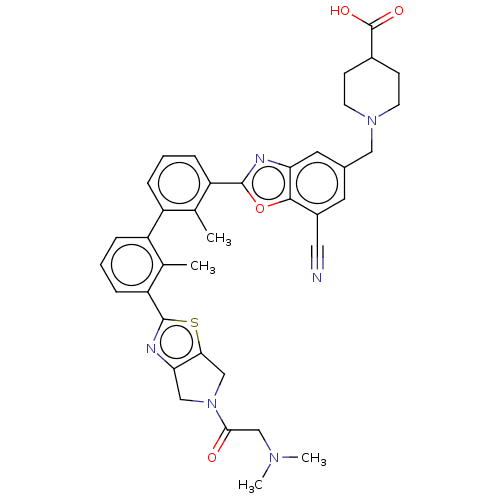Reaction Details Report a problem with these data
Report a problem with these data
 Report a problem with these data
Report a problem with these dataTarget
Programmed cell death 1 ligand 1 [19-238]/protein 1 [25-167]
Ligand
BDBM395626
Substrate
n/a
Meas. Tech.
TBD
IC50
3000±n/a nM
Citation
More Info.:
Target
Name:
Programmed cell death 1 ligand 1 [19-238]/protein 1 [25-167]
Synonyms:
PD-1/PD-L1
Type:
Protein
Mol. Mass.:
n/a
Description:
n/a
Components:
This complex has 2 components.
Component 1
Name:
Programmed cell death protein 1 [25-167]
Synonyms:
PD1 | PDCD1 | PDCD1_HUMAN | Programmed cell death protein 1 (25-167) | Programmed cell death protein 1 (aa25-167) | Protein PD-1 | hPD-1
Type:
Enzyme Catalytic Domain
Mol. Mass.:
15954.64
Organism:
Homo sapiens (Human)
Description:
Q15116 (aa25-167)
Residue:
143
Sequence:
LDSPDRPWNPPTFSPALLVVTEGDNATFTCSFSNTSESFVLNWYRMSPSNQTDKLAAFPEDRSQPGQDCRFRVTQLPNGRDFHMSVVRARRNDSGTYLCGAISLAPKAQIKESLRAELRVTERRAEVPTAHPSPSPRPAGQFQ
Component 2
Name:
Programmed cell death 1 ligand 1 [19-238]
Synonyms:
B7H1 | CD274 | PD-L1 | PD1L1_HUMAN | PDCD1 ligand 1 | PDCD1L1 | PDCD1LG1 | PDL1 | Programmed cell death 1 ligand 1 (aa19-238) | Programmed death ligand 1 | hPD-L1
Type:
Enzyme Catalytic Domain
Mol. Mass.:
25191.31
Organism:
Homo sapiens (Human)
Description:
Q9NZQ7 (aa19-238)
Residue:
220
Sequence:
FTVTVPKDLYVVEYGSNMTIECKFPVEKQLDLAALIVYWEMEDKNIIQFVHGEEDLKVQHSSYRQRARLLKDQLSLGNAALQITDVKLQDAGVYRCMISYGGADYKRITVKVNAPYNKINQRILVVDPVTSEHELTCQAEGYPKAEVIWTSSDHQVLSGKTTTTNSKREEKLFNVTSTLRINTTTNEIFYCTFRRLDPEENHTAELVIPELPLAHPPNER
Inhibitor
Name:
BDBM395626
Synonyms:
1-((7-cyano-2-(3'- (5-(2-(dimethyl- amino)acetyl)-5,6- dihydro-4H- pyrrolo[3,4-d]- thiazol-2-yl)-2,2'- dimethylbiphenyl- 3-yl)benzo[d]- oxazol-5-yl)- methyl)piperidine- 4-carboxylic acid | US10308644, Example 236 | US10800768, Example 236 | US11339149, Example 236
Type:
Small organic molecule
Emp. Form.:
C38H38N6O4S
Mol. Mass.:
674.811
SMILES:
CN(C)CC(=O)N1Cc2nc(sc2C1)-c1cccc(c1C)-c1cccc(-c2nc3cc(CN4CCC(CC4)C(O)=O)cc(C#N)c3o2)c1C

